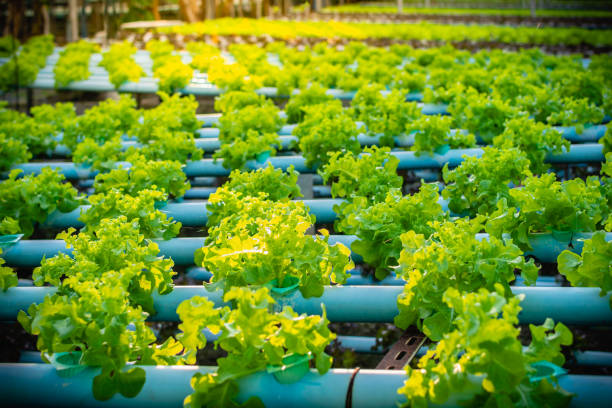Vertical Farming's Game-Changing Role in Sports Nutrition
Imagine a world where fresh, nutrient-dense produce is cultivated steps away from training facilities, tailored to athletes' specific needs. This isn't a far-off dream, but a burgeoning reality as vertical farming enters the arena of sports nutrition. By bringing hyper-local, precision agriculture into the world of athletic performance, this innovative approach is set to revolutionize how athletes fuel their bodies and recover from intense training.

The concept of applying vertical farming to sports nutrition stems from the growing recognition of the importance of personalized nutrition in athletic performance. Athletes require specific nutrient profiles to support their training regimens, recovery processes, and overall health. Vertical farming offers the ability to grow crops with precise nutritional content, tailored to meet these exacting needs.
Moreover, the controlled environment of vertical farms allows for the cultivation of plants with higher concentrations of beneficial compounds such as antioxidants, vitamins, and minerals. This level of control over growing conditions can result in produce that is not only more nutritious but also more flavorful, encouraging athletes to consume more of these health-promoting foods.
Customized Crop Selection for Athletic Performance
One of the most exciting aspects of integrating vertical farming into sports nutrition is the ability to select and cultivate crops specifically for their athletic benefits. For instance, leafy greens like kale and spinach, known for their high nitrate content, can be grown to boost endurance performance. Nitrates have been shown to improve oxygen utilization during exercise, potentially enhancing an athlete’s stamina and reducing fatigue.
Berries, rich in antioxidants, can be cultivated to aid in recovery by reducing oxidative stress and inflammation caused by intense training. Herbs like basil and oregano, which contain natural anti-inflammatory compounds, can be grown to support joint health and reduce muscle soreness.
Furthermore, vertical farming allows for the growth of lesser-known, nutrient-dense plants that may not be widely available through traditional agriculture. Microgreens, for example, can be grown quickly and efficiently in vertical systems and often contain higher concentrations of nutrients compared to their mature counterparts.
Precision Nutrition Through Controlled Growing Conditions
The controlled environment of vertical farms offers unprecedented opportunities for precision nutrition. By manipulating factors such as light spectrum, temperature, humidity, and nutrient solutions, farmers can fine-tune the nutritional content of crops to meet specific athletic needs.
For instance, research has shown that altering the light spectrum during plant growth can influence the production of certain phytonutrients. Red and blue light can enhance the production of antioxidants in some plants, while UV light can increase the synthesis of flavonoids, compounds known for their anti-inflammatory properties.
Similarly, adjusting the nutrient solution used in hydroponic or aeroponic systems can alter the mineral content of crops. This level of control allows for the cultivation of produce with optimal ratios of minerals like magnesium, potassium, and calcium, which are crucial for muscle function and recovery.
The ability to manipulate growing conditions also enables the production of crops with reduced antinutrient content. Antinutrients are compounds that can interfere with the absorption of certain minerals. By minimizing these compounds through controlled growing conditions, vertical farms can produce crops that offer enhanced nutrient bioavailability, ensuring athletes get the most benefit from their food.
Year-Round Availability and Reduced Environmental Impact
Traditional agriculture is subject to seasonal limitations and geographical constraints, often resulting in the need to transport produce over long distances. This not only affects the nutritional quality of the food but also contributes to a significant environmental footprint.
Vertical farming addresses these issues by enabling year-round production of fresh produce in close proximity to where it will be consumed. For sports teams and training facilities, this means access to peak-season quality produce throughout the year, regardless of location or climate.
The reduced transportation needs also result in a lower carbon footprint and decreased food waste. Produce can be harvested at peak ripeness and quickly delivered to athletes, ensuring maximum nutritional value and flavor. This freshness factor is particularly important for maintaining high levels of volatile compounds like vitamin C, which can degrade rapidly after harvest.
Moreover, vertical farming systems typically use significantly less water compared to traditional agriculture, often recycling and reusing water within the system. This efficiency is particularly valuable in water-scarce regions or in areas where water quality may be a concern for athletes.
Integration with Sports Science and Technology
The integration of vertical farming into sports nutrition opens up exciting possibilities for collaboration between agricultural scientists, nutritionists, and sports physiologists. By combining expertise from these fields, it becomes possible to develop crop varieties and growing protocols specifically optimized for athletic performance.
Imagine a scenario where an athlete’s physiological data, collected through wearable technology, could be used to inform the nutrient profile of their personalized produce. If an athlete shows signs of iron deficiency, for example, their vertical farm could adjust the growing conditions of leafy greens to enhance iron content.
This level of personalization extends beyond individual athletes to entire teams or sports. Different sports have varying nutritional demands, and vertical farms could be programmed to produce crops that cater to these specific needs. For instance, a farm supplying a basketball team might focus on foods that support quick energy release and recovery, while one serving endurance athletes might prioritize crops that enhance stamina and reduce inflammation.
Challenges and Future Directions
While the potential of vertical farming in sports nutrition is immense, there are challenges to overcome. The initial setup costs for vertical farms can be significant, and there’s a need for specialized knowledge to operate these systems effectively. Additionally, while vertical farming excels at producing certain types of crops, it may not be suitable for all the nutritional needs of athletes.
Research is ongoing to expand the range of crops that can be efficiently grown in vertical systems. Scientists are also exploring ways to enhance the nutritional density of vertically farmed produce further, potentially through the use of beneficial microorganisms or advanced LED lighting technologies.
Another area of development is the integration of vertical farming with other emerging technologies in sports nutrition. For instance, 3D food printing could be combined with vertically farmed ingredients to create personalized, nutrient-dense snacks or meals tailored to an athlete’s specific needs at different stages of training or competition.
The Role of Vertical Farming in Sustainable Sports Nutrition
As the sports industry increasingly focuses on sustainability, vertical farming offers a way to align nutritional needs with environmental consciousness. By reducing water usage, minimizing transportation, and eliminating the need for pesticides, vertical farms can significantly decrease the environmental impact of an athlete’s or team’s nutritional program.
This aspect of sustainability extends beyond environmental concerns to include social sustainability. Vertical farms can be established in urban areas, potentially providing fresh, nutritious produce to communities that may have limited access to such foods. This could have broader implications for public health and could even serve as a model for addressing food deserts in underserved communities.
Moreover, the educational potential of integrating vertical farming into sports nutrition programs is significant. Athletes, particularly those with high public profiles, could become advocates for sustainable, high-quality nutrition, influencing fans and the broader public to consider the source and quality of their food.
Vertical Farming and the Future of Sports Nutrition
As we look to the future, the integration of vertical farming into sports nutrition represents a paradigm shift in how we think about fueling athletic performance. It offers a way to provide athletes with ultra-fresh, nutrient-dense, and personalized produce while simultaneously addressing concerns about sustainability and food security.
The potential applications extend far beyond professional sports. College athletic programs, Olympic training centers, and even high school sports teams could benefit from the integration of vertical farming into their nutrition strategies. This could lead to a new generation of athletes who are not only more attuned to the importance of nutrition in their performance but also more aware of the broader implications of their food choices.
Furthermore, the lessons learned from implementing vertical farming in sports nutrition could have far-reaching implications for public health. As we gain a better understanding of how to optimize crop nutrition through controlled environment agriculture, these insights could be applied to address nutritional deficiencies and health issues in the general population.
A New Era of Performance Nutrition
The marriage of vertical farming and sports nutrition marks the beginning of a new era in performance nutrition. It represents a holistic approach that considers not just the nutritional needs of athletes, but also the environmental and social impact of food production.
As this field continues to evolve, we can expect to see more sophisticated integration of technology, nutrition science, and agriculture. The future may hold personalized vertical farms that automatically adjust growing conditions based on an athlete’s real-time physiological data, or AI-driven systems that predict and meet nutritional needs before they arise.
While challenges remain, the potential benefits of this innovative approach to sports nutrition are too significant to ignore. As athletes, teams, and sports organizations increasingly recognize the competitive advantage that optimal nutrition can provide, vertical farming is poised to play a crucial role in shaping the future of athletic performance and recovery.
In embracing this technology, the sports world has the opportunity not only to enhance athletic performance but also to lead the way in sustainable, high-quality food production. As vertical farming continues to grow and evolve within the realm of sports nutrition, it may well prove to be one of the most significant advancements in athletic performance and recovery in the coming decades.





